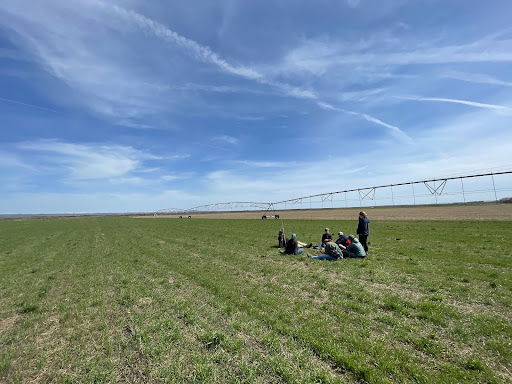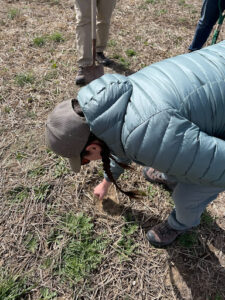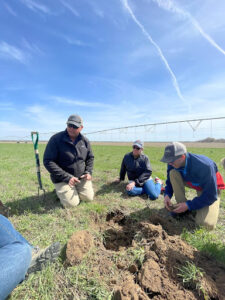Regenerative agriculture in practice: Touring Ernie’s Organics
On a warm but windy April morning, ICL staffers from our Snake River, Climate and External Relations teams met up just west of Shoshone, Idaho, for a personalized tour of Ernie’s Organics farm. The lava flows speckling the landscape with dark rocks and Central Idaho’s snow covered mountains to the north served as a visual reminder of how harsh Idaho’s growing environment can be for farmers.  We joined Rich Bupp, Executive Director of EarthKnowSys, a local nonprofit that helps farmers and other natural resource managers choose more sustainable practices in their operations, for the tour. With Rich’s support, Ernie’s Organics has been utilizing many regenerative agriculture practices, including using no-till equipment and cover cropping to increase soil health and reduce water quality impacts, all while still yielding strong harvests.Tilling techniques and cover cropsMany different fields of crops at Ernie’s Organics utilize different soil and irrigation techniques for improving soil health and minimizing water usage. At each field, we compared the temperatures between the soil surface, growing zone, and deep soil to understand how cover crops can help insulate soil. Additionally, we took a few soil samples to visually compare how different tillage practices impact the compaction and organic matter in the soil.
We joined Rich Bupp, Executive Director of EarthKnowSys, a local nonprofit that helps farmers and other natural resource managers choose more sustainable practices in their operations, for the tour. With Rich’s support, Ernie’s Organics has been utilizing many regenerative agriculture practices, including using no-till equipment and cover cropping to increase soil health and reduce water quality impacts, all while still yielding strong harvests.Tilling techniques and cover cropsMany different fields of crops at Ernie’s Organics utilize different soil and irrigation techniques for improving soil health and minimizing water usage. At each field, we compared the temperatures between the soil surface, growing zone, and deep soil to understand how cover crops can help insulate soil. Additionally, we took a few soil samples to visually compare how different tillage practices impact the compaction and organic matter in the soil.  First, we stopped at your typical early spring crop fields. These fields looked like bare or mostly bare dirt with some obvious lines from planting seeds. Rich told us that these fields had been tilled within the past year to harvest potatoes. Tilling has been done historically to remove potential weeds, mix upper and lower soil types, and loosen and aerate the soil for new plant growth, but it comes with a price. Tilling is a mechanical disturbance to your crop field – it disrupts the soil structure, causes erosion, and breaks the microbial ecosystem. These impacts were evident in the soil we examined. We used thermometers to measure the temperatures of the soil surface, then in the top 2 inches of soil (known as the germination or growing zone), and the deeper soil temperatures. We observed very small differences between the temperatures on the soil surface, the growing zone, and the deep soil. When we used a shovel to take a soil sample, we saw that this tilled field also had extremely uniform, compacted soil with very little root systems or animal life in it. The wind kicked up a lot of dust from this field as well. Next, we compared the freshly tilled field with a field that had grown wheat as a cover crop over the winter. Upon first glance, this field looked like mostly bare dirt with some leftover harvest material on top. The cover crop field had more roots and aggregations, or soil clumps, along with more worms and arthropods in the soil sample. These soils also had larger differences in temperatures between the soil’s surface and the growing and deep zones, which suggests that the cover crop and resulting organic matter helps to insulate the soil. Rich told us that this organic matter not only helps to increase microbial activity but also helps to retain both water and carbon within the soil – good for crops, and the environment. Finally, we stopped at a field that looked more like someone’s yard than an early spring crop field – bright green grass soaking up the sunshine with only a few spots of bare dirt poking through. Rich shared with us his long-term experiment at Ernie’s Organics: a 3-year cover crop with cereal rye on an edible beans field. Cereal rye, Rich told us, can grow to about six feet high. Rich even helped to create a special tool, called a crimper, to fold over the cereal rye so that the organic matter of the stalks and leaves would add more carbon and nutrients to the soil. Using this cereal rye as a cover crop helped to add biomass at the rate of 18 tons per acre on this field. This soil sample had the most soil aggregation, root matter, and worm and arthropod activity. This field also had the largest difference in surface temperature and growing zone and deep soil temperatures, showing how effective the cover crop was at steadying soil temperature, water, and carbon within the soil.
First, we stopped at your typical early spring crop fields. These fields looked like bare or mostly bare dirt with some obvious lines from planting seeds. Rich told us that these fields had been tilled within the past year to harvest potatoes. Tilling has been done historically to remove potential weeds, mix upper and lower soil types, and loosen and aerate the soil for new plant growth, but it comes with a price. Tilling is a mechanical disturbance to your crop field – it disrupts the soil structure, causes erosion, and breaks the microbial ecosystem. These impacts were evident in the soil we examined. We used thermometers to measure the temperatures of the soil surface, then in the top 2 inches of soil (known as the germination or growing zone), and the deeper soil temperatures. We observed very small differences between the temperatures on the soil surface, the growing zone, and the deep soil. When we used a shovel to take a soil sample, we saw that this tilled field also had extremely uniform, compacted soil with very little root systems or animal life in it. The wind kicked up a lot of dust from this field as well. Next, we compared the freshly tilled field with a field that had grown wheat as a cover crop over the winter. Upon first glance, this field looked like mostly bare dirt with some leftover harvest material on top. The cover crop field had more roots and aggregations, or soil clumps, along with more worms and arthropods in the soil sample. These soils also had larger differences in temperatures between the soil’s surface and the growing and deep zones, which suggests that the cover crop and resulting organic matter helps to insulate the soil. Rich told us that this organic matter not only helps to increase microbial activity but also helps to retain both water and carbon within the soil – good for crops, and the environment. Finally, we stopped at a field that looked more like someone’s yard than an early spring crop field – bright green grass soaking up the sunshine with only a few spots of bare dirt poking through. Rich shared with us his long-term experiment at Ernie’s Organics: a 3-year cover crop with cereal rye on an edible beans field. Cereal rye, Rich told us, can grow to about six feet high. Rich even helped to create a special tool, called a crimper, to fold over the cereal rye so that the organic matter of the stalks and leaves would add more carbon and nutrients to the soil. Using this cereal rye as a cover crop helped to add biomass at the rate of 18 tons per acre on this field. This soil sample had the most soil aggregation, root matter, and worm and arthropod activity. This field also had the largest difference in surface temperature and growing zone and deep soil temperatures, showing how effective the cover crop was at steadying soil temperature, water, and carbon within the soil.  What does this tell us?This visit showed us strong examples of how healthy soil practices can positively impact the surrounding environment. The Little Wood River flows through Ernie’s Organics, and on this farm – the water was crystal clear. We saw a merganser take off from the river as we crossed over the farm’s well-used bridge. Members of our team took turns using a pair of binoculars to watch an adult and subadult bald eagle stalk a busy Great Blue Heron rookery that lined the river. The tour served as a reminder of how water is the lifeblood of agriculture – soil quality, water quality, and overall environmental quality are inextricably linked.
What does this tell us?This visit showed us strong examples of how healthy soil practices can positively impact the surrounding environment. The Little Wood River flows through Ernie’s Organics, and on this farm – the water was crystal clear. We saw a merganser take off from the river as we crossed over the farm’s well-used bridge. Members of our team took turns using a pair of binoculars to watch an adult and subadult bald eagle stalk a busy Great Blue Heron rookery that lined the river. The tour served as a reminder of how water is the lifeblood of agriculture – soil quality, water quality, and overall environmental quality are inextricably linked.  Regenerative agricultural practices increase the land’s ability to filter and retain water, making farms more resilient to drought and floods while also reducing erosion and polluted runoff of excess nitrogen, phosphorus, pesticides, and other chemicals from fields. Both surface water and groundwater in southern Idaho are heavily impacted by nitrogen and phosphorus pollution, a problem that could be mitigated to some degree by farmers’ adoption of these kinds of practices.Rich was quick to tell us that not every new tactic for soil and water conservation work immediately. He showed us one field where they planted alfalfa using a no-till planter that had barely sprouted. Instead of the entire field being covered in short green bushes with delicate purple flowers, we saw just a few clusters of alfalfa sporadically sprouting across the field. Rich hypothesized that this outcome was due to equipment error, and he was in the process of working to repair the no-till planter to avoid this problem in the future. He went on to mention how the cereal rye in the long-term cover crop field had even choked out some of the edible bean crops from too much biomass, suggesting that you can have too much of a good thing. When it comes to regenerative farming practices, new technology and techniques must be combined with patience, positivity, resilience, and a bit of luck. Farming is not a one-size-fits-all for any operation.
Regenerative agricultural practices increase the land’s ability to filter and retain water, making farms more resilient to drought and floods while also reducing erosion and polluted runoff of excess nitrogen, phosphorus, pesticides, and other chemicals from fields. Both surface water and groundwater in southern Idaho are heavily impacted by nitrogen and phosphorus pollution, a problem that could be mitigated to some degree by farmers’ adoption of these kinds of practices.Rich was quick to tell us that not every new tactic for soil and water conservation work immediately. He showed us one field where they planted alfalfa using a no-till planter that had barely sprouted. Instead of the entire field being covered in short green bushes with delicate purple flowers, we saw just a few clusters of alfalfa sporadically sprouting across the field. Rich hypothesized that this outcome was due to equipment error, and he was in the process of working to repair the no-till planter to avoid this problem in the future. He went on to mention how the cereal rye in the long-term cover crop field had even choked out some of the edible bean crops from too much biomass, suggesting that you can have too much of a good thing. When it comes to regenerative farming practices, new technology and techniques must be combined with patience, positivity, resilience, and a bit of luck. Farming is not a one-size-fits-all for any operation.
To understand more about how soil health impacts climate, sign up for our climate/ag emails here. To understand more about water quality in the Snake River watershed, sign up for our Snake River emails here.

